Uganda under Museveni is a beacon of instability
Uganda under Museveni is praised as a ‘beacon of stability’ by most Western countries. Highly paid American lobbyists, World Bank officials, diplomats and politicians from donor countries that enlist his military have protected the reputation of Museveni. This ‘branding’ has been so effective that in 2004 Museveni was even praised by the Nobel Peace Prize committee for his efforts in resolving regional conflicts. Western journalists have, knowingly or not, tended to downplay his abuses or divert attention by criticizing opposition (Epstein 2021).
Dutch journalist Arne Doornebal, who lived in Uganda for many years (and thus should know better), titled his book ‘Uganda under Museveni’ with the sub-title: ‘He dethroned a dictator, is he now to become one himself?’ This was published in 2020, 34 years after bloodshed under the dictator. Most prominent references? ‘Sowing the Mustard Seed’ by Museveni (1997) himself, and several interviews with one of his most loyal ambassadors: Mirjam Sow-Blaak. Doornebal does not stand alone in his politeness towards the regime of Museveni. A telling experience with Dutch expat communities is their resistance against political activists & opposition, and adherance to the status quo of Museveni. Besides these journalists and expats, there is the embassy itself. The embassy of the Netherlands wrote the following in their Multi-Annual Country Strategy 2019-2022:
Uganda, being part of two unstable regions, the Great Lakes and the Horn of Africa, enjoys relative political stability. Uganda is an important player in both regions. It contributes considerably to peacekeeping missions, and plays a mediating role in establishing political stability in South Sudan and Burundi. Moreover, Uganda is now the largest refugee-hosting country in Africa, with a progressive open door for refugees mainly coming from South Sudan and DRC.
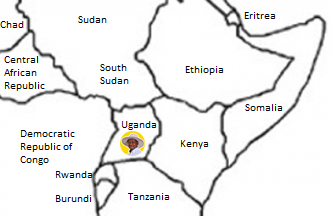
In this blog, I will illustrate how this narrative of Uganda as a positive force for peace, a ‘beacon of stability’, is state propaganda. It is time that the West take off their blindfolds about the blood on the hands of Museveni. In my earlier research on Uganda I found that there are two perspectives. The outside-in perspective is based on the narrative of the Ugandan government, that is reproduced by Western governments, diplomats, and journalists. In contrast to this outside-in narrative stands the inside-out narrative of the local population, activists, and academics. These perspectives are often completely different, and this makes it difficult to know the truth. In this blog, we will focus on the inside-out perspective of journalists and academics that try to unravel the state propaganda of Uganda and its donors.
A crucial person in this is Helen Epstein, an American professor of human rights and public health. In her book (2017) Another Fine Mess: America, Uganda, and the War of Terror she exposes how Museveni has been at the center of violent political instability in the Great Lakes and Horn of Africa. Most references in this blog, are based on the book Another Fine Mess, which is again based on more than 200 journalist and academic sources. I recommend all to read the book of Epstein, which might be the most urgent and important book on Uganda at this moment, and which is available on: https://www.amazon.com/Another-Fine-Mess-America-Columbia/dp/0997722924
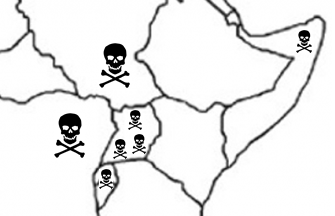
After reading the book, you find out how Museveni has been a crucial (hidden) force in several of the most deadly civil wars in Africa for the past 40 years. An image occurs of a cunning African Bismarck that destabilizes whole nations for his own interests. In this blog we will delve into the unknown stories of Museveni in Uganda, Rwanda, Congo, South Sudan, and Somalia.
Uganda Civil War (Bush War)
100.000 to 500.000 casualties
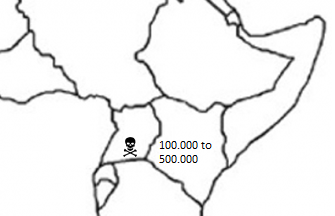
Museveni launched the guerrilla war, known as the ‘Bush War’ in 1981 after he claimed that Obote had rigged the elections. An estimated 100.000 to 500.000 civilians died, but it is likely that Museveni inflated the numbers to make the Obote regime look worse. The atrocities of the Obote government are undeniable and known, but it is important to note that the NRA also committed atrocities, although they were far less brutal and numerous than those committed by Obote’s army. Some killings were reprisals against traitors, other false flag attacks, attack made look like government attacks but in fact NRA attacks. Several NRA veterans told Helen Epstein that they burst into houses, dragged them in forest, and killed them. In 2011 memoir, NRA major John Kazoora describes NRA massacre:
‘They would dig a shallow grave, tie you up and lie you facing the ground and crack your skull using an old hoe.’
In 1983 Museveni ordered the NRA to target Westerners. A Canadian engineer, and four European aid workers, were killed. Museveni was a master of propaganda. When British journalist William Pike was invited to the NRA camps, he was shown five mass graves with thousands of skulls, list of 30 such sites, and Musevemi claimed that the army had killed 300.000 people. When a journalist of the Daily Telegraph visited one of the places, he could find nothing to support these claims.
North Uganda Civil War
100.000+ casualties
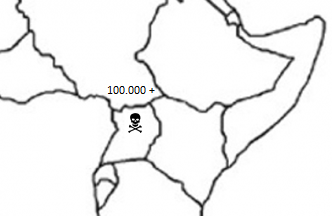
Although the civil war was ended in South Uganda, it continued in Northern Uganda. Government forces attacked former strongholds of the Obote government, in Acholi and Teso. Epstein narrates how the NRA’s 35th battalion, in early august killed and used a torture method called three-piece on 80 villagers. Next morning many more were loaded in trucks and departed, and killed. When in october 1986 Museveni met with USA ambassador Robert Houdek, the ambassador asked about the three-piece torture. ‘Why should the three-piece-tie be America’s concern?’ Asked Museveni. ‘Because it is a form of torture and a violation of human rights.’ The ambassador replied.
The state violence used against the inhabitants led to two insurgency forces to grow, Alice Lakwena and her nephew Joseph Kony. The devastation that followed is well known. Although several months occurred that could have led to peace, Museveni hijacked all these efforts. In 1992 Kony was severely wounded, and was about to be picked up by general Sejusa, who was then ordered to stop the operation without explanation by Museveni. In 1994, Betty Bigombe started peace talks, when on February 6 Museveni suddenly gave an ultimatum, and Kony had to continue fighting. Bigombe has always insisted Kony wanted peace but whenever she tried to contact him, the army would track her phone or radio signals and attack Kony’s camp. In 2002, catholic priests arranged to meet with Kony commanders to arrange for peace. Suddenly attacked by the army, almost burning the priests alive. They were pressured by army to sign a confession. While most attention has been given to the atrocities of Kony, the atrocities of the government are often ignored.
Another element that is often ignored is the cattle raids. Officially cattle raids were blamed on Karamajong, By mid 1990’s, 300.000 animals lost by Acholi. But the inhabitants doubted this government (outside-in perspective).
After all, why were the rustlers wearing gumboots, rather than going barefoot or wearing Karamajong sandals? And why were the trucks with the animals heading south, towards Kampala, rather than north or east, where the Karamajong live? And since when did the Karamajong acquire helicopter gunships, which were reportedly seen during some of the raids? Why did the NRA disarm the Teso and Acholi, while allowing Karamajong to keep their weapons? To some, it seemed as though Museveni was punishing entire tribes, millions of people, for the crimes of the relatively modest number of soldiers responsible for the worst abuses in Luwero.
Political Murders in Uganda
500+ casualties
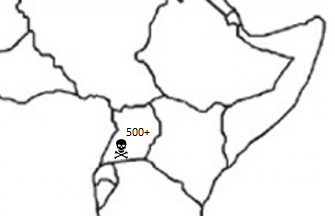
Soon after the NRA takeover political opponents started to be arrested. Since 1989 and 1992 Amnesty International published reports, where NRA detained suspects without trial for months, ignored court cases. In secret prisons, suspects beaten with iron rods, had nails drilled in their heads, and their genitals electrocuted, stapled, and crushed with pliers. Most prevalent torture method was three-piece-tie, in which arms of victim are tied tightly behind back above the elbows so that the chest protrudes outward, producing searing pain. Sometimes the legs were also bound to the hands of the victim and the victim was hung from a tree or a rafter. Torture, and illegal detention, is nothing new in Uganda. It has been there for at least the past 32 years, confirmed by these Amnesty reports. In Kasese 2016, more than a hundred were killed. In Kampala during riots in November 2020, more than 50. Hundreds (if not thousands) of other cases are known of people that are killed in Uganda due to political reasons. Political stability in Uganda is an illusion.
Rwanda Civil War and Genocide
500.000 to 800.000 casualties
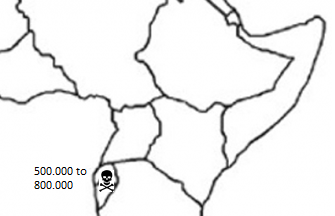
During the 1981-86 Bush War, Rwandese soldiers played a crucial role. Afterwards they formed themselves in Uganda, in the Rwandan Patriotic Front, RPF. These were Tutsi rebels renown for brutality during the Ugandan wars (in Luwero and Northern Uganda), many top leadership functions in NRA were Rwandan. Kagame was chief of military intelligence, headquartered in one of the torture houses. In Corner Kilak in Northern Uganda, 600 unarmed men and women rounded up in cold blood by these Rwandese soldiers. In 1990, thousands of RPF fighters invaded Rwanda from Uganda. After an initial defeat by Rwandese army army, helped by French and Zairean commandos, they established bases in the Virunga mountains. Their food and weapons were supplied by Museveni. In 1992 the USA monitored weapon shipments from Uganda to Rwanda, but instead of stopping it, they doubled aid to defense spending of Museveni. The civil war led to an increasing radicalization of Hutu/Tutsi tension. Under immense international pressure, in August 1993 the Rwandan president agreed to grant the RPF seats in a transitional government and nearly half of all posts in the army. Hutu mayors and other local officials were already stockpiling rifles, and militias distributing machetes and kerosene.
In January 1994, the CIA predicted that if tensions were not somehow defused, hundreds of thousands of people might die in ethnic violence. There are several lines of evidence that is was RPF that shot down the plane of the president, which provided the spark for the genocide. The missiles were Russian made SAM-16’s which Rwandan did not have, but RPF did. The United Nation estimated that RPF killed some 10.000 civilians each month during the genocide. An Ugandan journalist that had also witnessed Bush war and North Uganda witnessed something strange: of dead bodies in RPF areas, he saw that many were tied three-piece, the infamous torture method used by NRA in Northern Uganda.
Congo Civil War
250.000 to 800.000 casualties
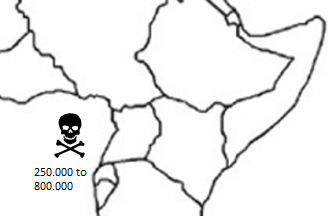
After the Rwandan genocide, more than a million Hutu refugees, also about 30.000 genocidaires, government officials, ex-Rwandan army soldiers, members of the vicious Interahamwe, fled to Eastern Congo. Between 1995-1996 attacks were made from these camps, after which RPF responded in kind, with thousands of deaths. Hutu militants saw Museveni as the mastermind behind of the RPF conquest of their country. In 1996 a joint invasion of Ugandan and Rwanda started with rebel leader Joseph Kabila to overthrow Mobutu. In the take over of Eastern Congo, massive pillaging started. In 2005, Congo sued Uganda for 10 billion in reparations, Uganda continues to back rebel groups like M23. UN has accused this group of mass rape, looting, summary execution, and other crimes. An UN report in 2012 exposed that the Ugandan regime had provided logistical and military support to the M23 rebel group in Eastern Congo. Then Museveni threatened to pull out of the Somali mission, and the donors remained silent about the report in further debates.
South Sudan Civil War
400.000 + casualties
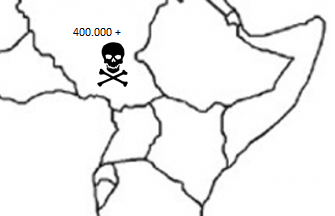
USA officials met Garang (South Sudanese rebel leader of SPLA) already in 1990, and Ugandan officials were arrested when they tried to smuggle 400 anti-tank missiles out of US, alongside 34 launcher. A year later the case was quietly dropped, as an US judge determined that the US has approved this mysterious deal. Throughout 1990s, SPLA troops were training in Uganda, and receiving military hardware such as heat-seeking chaparral missiles, hawk ground-to-air-missiles, howitzers, TOW anti-tank missiles, Vulcan cannons. Although western donors deny assistance, the military assistance to Uganda soared around this period. The Sudanese military responded again by arming the LRA of Joseph Kony and so gravely destabilizing both the Sudanese and Ugandan civil wars.
As the Acholi population was known to be anti-government, Museveni forced them into internment camps, for own protection. This was about 2 million. So the refugee camps in Northern Uganda are not the result to help local in habitations, but the results of state campaigns of dislocation and involvement in civil war.
Somalia Civil War
300.000 to 500.000 casualties
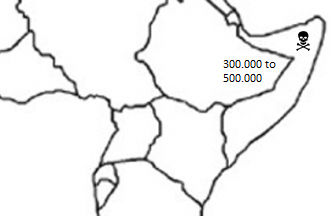
In contrast to violence in the Uganda, Rwanda, Congo, and South Sudan civil wars, Ugandan forces or support in AMISOM do not destabilize the conflict in Somalia, but act as a stabilizing peacekeeping force instead.
In 2006 Somali Islamists, Islamic Courts Union (ICU) took over Mogadishu. On Christmas eve Ethiopian tanks flattened entire neighborhoods in the city after their USA backed invasion, a month later the UN security council allowed AU peacekeeping mission, few supported the unprovoked assault on Somalia, but US and European allies had been preparing Museveni troops for months. The AMISOM mission, continues to earn the Museveni regime around 20 million dollars a year up to today. Meanwhile, many Ugandan AMISOM troops complain that they live in miserable conditions and sometimes aren’t paid for months at a time. In 2013, Museveni son and head of Special Forces Command Muhoozi visited Somalia and asked AMISOM troops to share their concerns. When a soldier questioned why members of some tribes seldom received promotions, whereas members of the Presidents clan moved rapidly through the ranks, he was arrested. In 2017, a soldier accused of stealing ammunition was tortured by having a 15 kilogram sack of weights tied to his penis.
Conclusion
Uganda under Museveni has never been a ‘beacon of stability’. Instead, it has been the center of violent instability in the Great Lakes and Horn of Africa regions. It is terrible to realize that Museveni is praised by the European Union for hosting the largest refugee population in Africa. As showed in this blog, it was Museveni himself who created all those displacements and human misery in North Uganda, Congo, and South Sudan. This complete hypocrisy is telling for the actual deeds of Museveni compared to state/donor narratives. Museveni is adept in the use of force for political gains, an African Bismarck with Machiavellian practices. However, Museveni is also a true master of propaganda and manipulation. He has been able to maintain his ‘outside-in’ perspectives and fool the Western donors for the past 40 years. But we should also not give these Western donors and their journalists too much credit in being ignorant. It is almost impossible to remain blind for the bloodshed of Museveni. Dozens of scholars have written about the corruption, oppression, torture, and massacres at the hands of Museveni. All the evidence is there in plain sight. It is high time we do not accept the continued propaganda and branding of Museveni any longer, and call out any who downplay the bloodshed in and around Uganda. There is a compelling reason to believe that these ambassadors simply do not want to change their support. Last Thursday, 19 February 2021, European diplomats posed with Museveni after a private meeting.
The blood of millions of innocent Africans in Uganda, Rwanda, Congo and South Sudan, is on the hands of Museveni and his soldiers. Indirectly, this blood is caused by the continued donor support of maintaining Museveni in power. With their financial and diplomatic support, and the many billions of dollars to the Ugandan government, they have allowed Museveni to act as a ‘beacon of instability’. If the donors want to support the African populations, and ensure real peace in the region, they should distance themselves from Museveni as soon as possible.
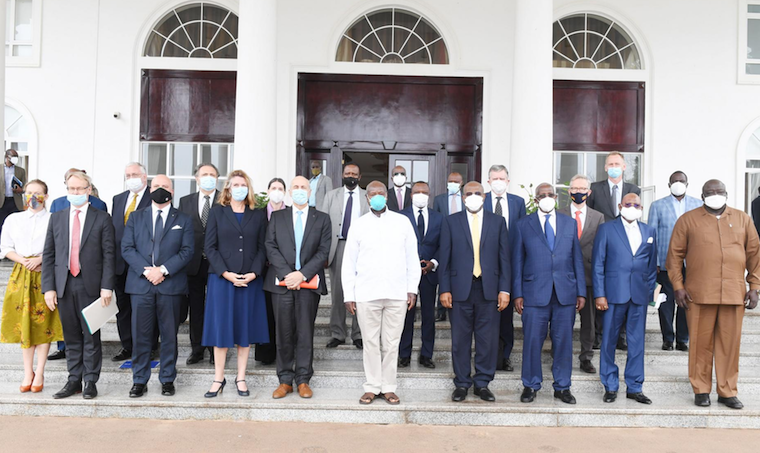
Erik van der Zanden

Picture by Glenn Fawcett